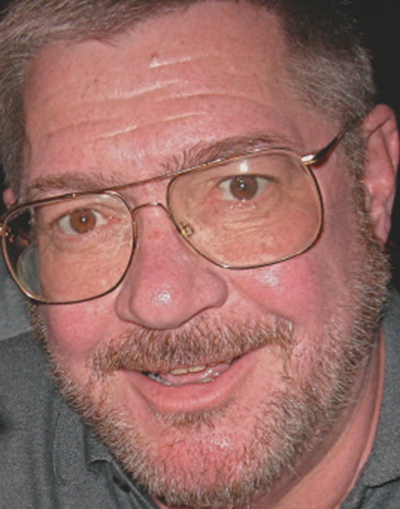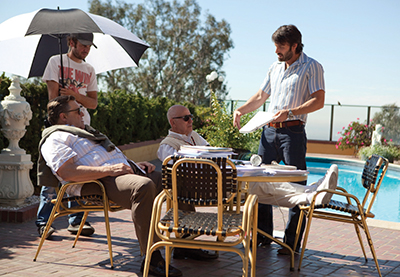Goldenberg Balances ‘Argo’ Storyline via Strategic Editing

Jay Ankeney
LOS ANGELES -- When William Goldenberg A. C. E., accepted the Oscar for “Best Achievement in Editing” for “Argo” from the hands of Sandra Bullock in February during the 85th Annual Academy Awards at the Dolby Theater in Hollywood, not everyone was surprised. I had actually made a point of interviewing Goldenberg last October right after seeing that remarkable film because I was so struck by the skill and artistry with which he had paced the kaleidoscope of images through which he helped director Ben Affleck and fellow Oscar winner, screenwriter Chris Terrio, tell a tale that, if we didn’t know up front was based on historic fact, would seem over the top for even a Hollywood film.
But its very complexity meant “Argo” was not an easy feature to put together. “We used a variety of media to tell the story since Ben and cinematographer Rodrigo Prieto decided to have a different visual feel for every location in which the film took place,” Goldenberg said. “So it was shot mostly on film, some 2-perforation flat, some 4-perf anamorphic, and we even used some Super 8mm and 16mm to augment archival newsreels, although a couple of the scenes shot in Turkey were recorded with an ARRI Alexa digital cinema camera.”
DUELING STORYLINES
This mixture of formats facilitated the film’s storytelling motif of often portraying two storylines at once: The travails of the six refugees from the U.S. Embassy being hidden in the home of the Canadian ambassador right in the midst of the November 1979 riots in Iran after the revolution inspired by Ayatollah Khomeini, and the unfolding plot conjured up by a CIA “exfiltrator” expert, Tony Mendez (Ben Affleck), to free them under the guise of being members a Hollywood film crew filming a science fiction indie on location in Iran called “Argo.”

William Goldenberg Of course, by the time the footage got to Goldenberg, his talented additional editor Brett Reed, assistant editor Joe Galdo and apprentice Maria Paula Galdo had massaged it all into the DNxHD format that his Avid Media Composer prefers.
Goldenberg said he considered the U.S. Embassy takeover at the beginning of the film the most challenging scene to edit.
“Ben and I decided to do this sequence without any music,” he said. “It was structured around realistic sounds of the crowd chanting and shouting, and ended up being more visceral and less story illustrative than the way it was described in the original script. So we progressively kept taking out specific story elements to make the sweep of the action feel more breathless. In the end, we played it from the point of view of the people in the embassy and accelerated the intercuts to show that these six people were the focus of the narrative we were telling.”
The professional video industry's #1 source for news, trends and product and tech information. Sign up below.
It’s an indication of the multilevel storytelling conveyed through Goldenberg’s editing that during this sequence it becomes apparent the Americans are primarily concerned with getting the innocent Iranian house guests out of the embassy, while not portraying the rioting protesters outside as manic cartoon characters. This is a tale of real passions on both sides of the issue, and the filmmakers intentionally rejected taking cheap shots while portraying its intensity.
“I’d say half of the dialogue during this sequence was scripted, half of it was improvised,” he said. “Each take was different from the last, but we used the dialogue as a framework to give the audience the feeling they were in the middle of the action. The six actors portraying the Americans had actually spent a week living in the residence completely shut off from the outside world so they could develop a believable sense of camaraderie.”
AFFLECK’S EYE FOR EDITING
Goldenberg worked closely with Affleck while editing the film during principle photography, but their schedules converged only on weekends. “While Ben was shooting I was cutting on my own, but we would get together in an editing room in his house on Sundays,” he said, “and then I would make adjustments during the following week. During post production, Ben looked at all the footage with me and selected the specific performances he wanted to highlight. Some directors don’t have the patience for this, but Ben has a terrific eye for editing.”

Argo’s very complexity made the film a challenge to edit. Goldenberg and Affleck had worked together previously on Affleck’s 2007 directoral debut, “Gone Baby Gone,” on which they took Affleck’s own rough cut and fine-tuned it under Goldenberg's discerning eye. That helped them communicate efficiently on “Argo.”
“It was a complete collaboration between us,” Goldenberg said, “and we are both very proud of the result.”
“Argo” is in large part a tale of two stories: The ordeal of the hostages and the often comedic efforts of Hollywood insiders in helping a CIA operative rescue them. Among the rich editorial possibilities this opened up for Goldenberg, one of his favorites was the scene during which the Hollywood producers of “Argo” (Alan Arkin and John Goodman) stage a fake script read-through for the press. At the same time, Goldenberg juxtaposed the intimidation of the real U.S. Embassy hostages by the Iranian militants which included a mock execution.
Surprisingly, Goldenberg said this Hollywood press opportunity actually took place and replications of the real “Argo” ad printed in Variety can really be seen in the background. Several of those original drawings, drawn by Jack Kirby, are still on display in the Spy Museum in New York.
But it’s the climactic scene of Affleck’s character trying to get the refugees through Iranian security and onto the plane to freedom that Goldenberg best remembers.
“This script was an editor’s dream,” he said. “I’ve never seen a tension sequence that was written as well as Chris accomplished with his written intercutting during that scene, so the challenge was to keep all the multiple storylines credible. My goal was to build one on top of the other and keep it believable.”
The audience knows the real refugees got away so how did that affect Goldenberg’s editing decisions?
“That’s a great question,” hesaid. “But it probably did not influence my cutting because I approached the scene as if the people watching the movie did not know the ending. We cut it the way the scene seemed to require, letting the tension increase as the action gained momentum. My editing is all derived from the story’s objective needs.”
Jay Ankeney is a freelance editor and post-production consultant based in Los Angeles. Write him atJayAnkeney@mac.com.
A ‘Golden’ Legacy
William Goldenberg also shared an Oscar nomination this year with Dylan Tichenor for “Zero Dark Thirty.” He had been nominated twice before, for “Seabiscuit” in 2003 and “The Insider” in 2000.
His work on “Argo” also earned editing awards this year from:
• American Cinema Editors
• British Academy of Film and Television Awards
• Critics Choice Awards
• Phoenix Film Critics Society
• San Diego Film Critics Society
• San Francisco Film Critics Circle
